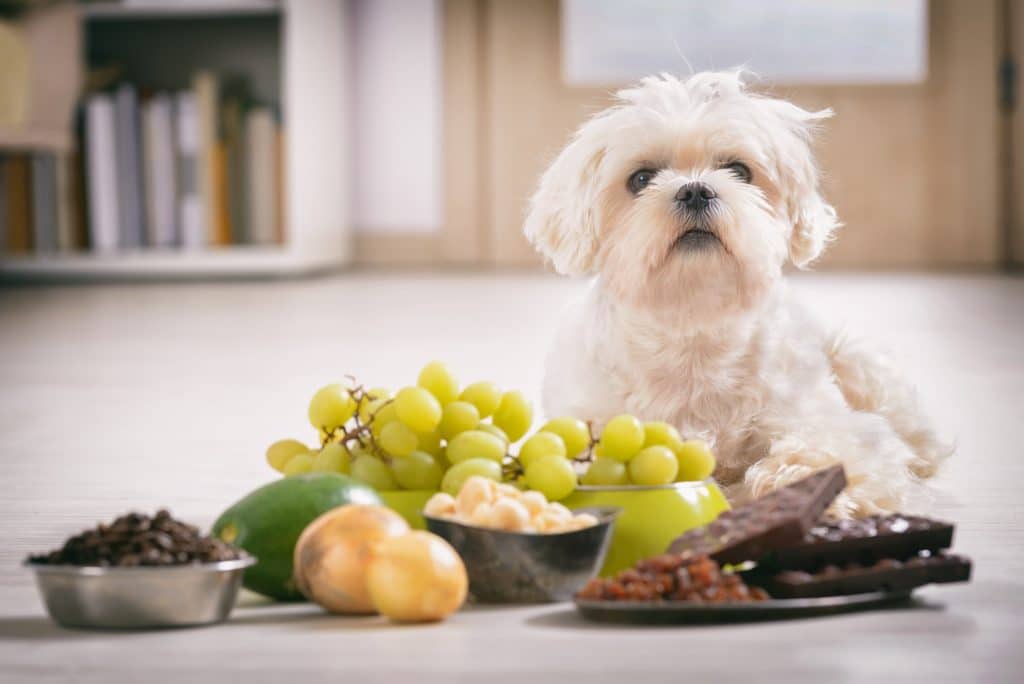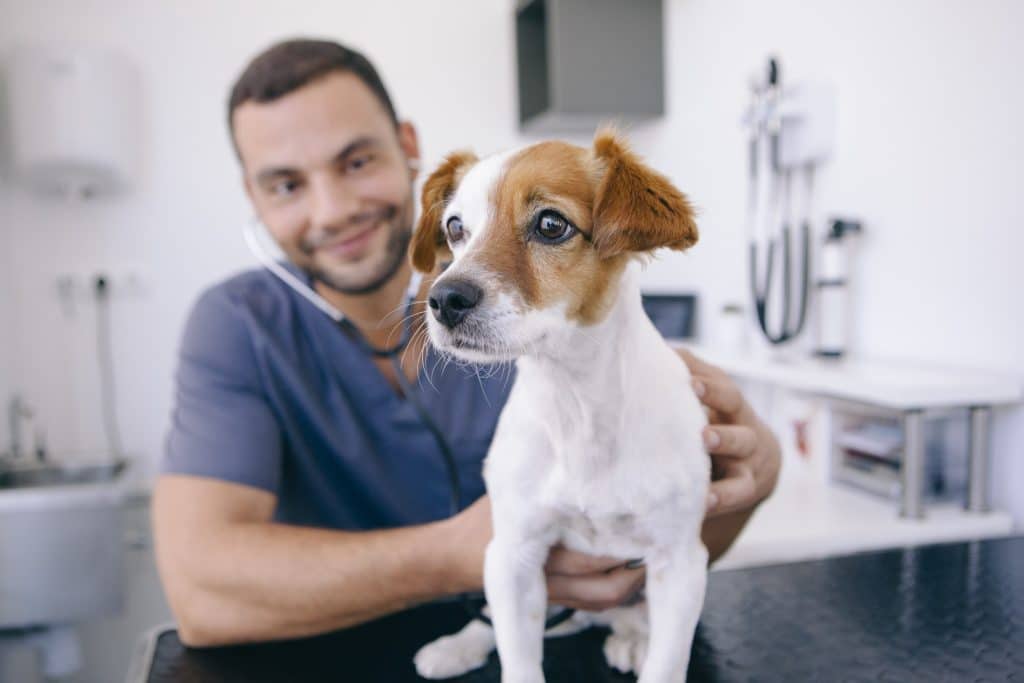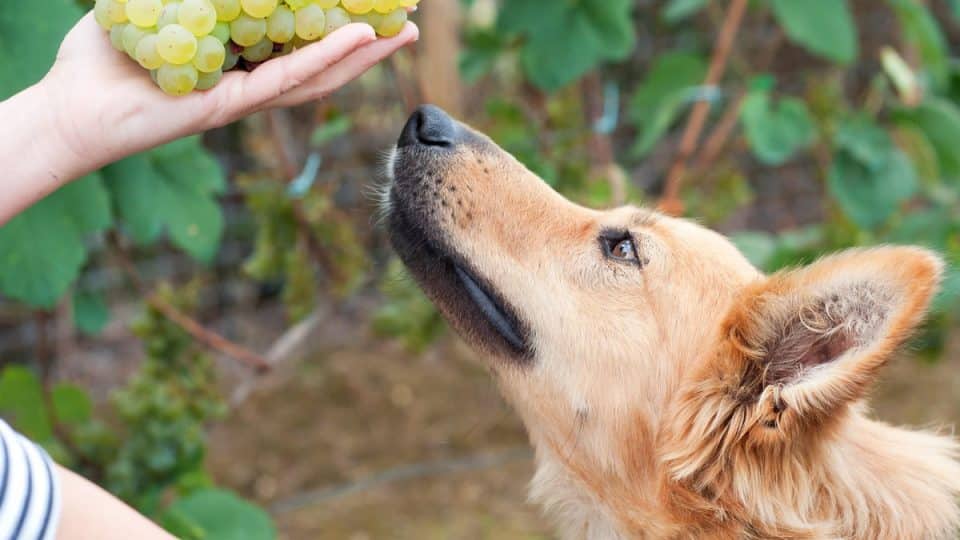Though small, grapes can significantly impact your dog’s health. While some dogs won’t exhibit any side effects after eating grapes, others will. These can range from mild vomiting to more severe symptoms like acute kidney failure. Other common signs your dog’s eaten a grape include diarrhoea, lethargy, and frequent peeing.
If your dog does eat grapes, don’t panic. “If we catch toxicity early—where they just have an upset tummy—then the prognosis is always really good,” says Dave Leicester, a leading emergency vet in charge of Video Vets Now, a telehealth service from Vets Now. If left untreated, grapes can potentially be deadly to your dog.
Read on to learn more about the potential hazards of grapes, what to do if your dog has eaten some, and what fruits are actually safe for dogs to eat.
Can Dogs Eat Grapes?
While prompt treatment can have positive outcomes, it’s best to avoid letting your dog eat grapes—a single grape or an entire bunch.
Dr Carly Fox, a senior vet at Schwarzman Animal Medical Center in NYC, USA, says if dogs have even one grape, seek emergency medical care. “The negative effects of grape ingestion vary greatly, she adds. “There is no way to know if your pet will become sick.”
While dogs should avoid grapes themselves (seedless or otherwise), they should also avoid products containing grapes in various shapes and forms, including:
- raisins
- currants
- sultanas
- fruit cake
- cookies
- hot cross buns
- raisin bagels
- jam
- jelly
- wine
- grape juice

iStock/yacobchuk
Why are grapes so bad for dogs?
Lots of foods can be dangerous for dogs. So what exactly is it about grapes that make them harmful? “Previously, the toxic effects of grape ingestion were thought to be idiosyncratic, and the cause of toxicity was unknown,” Dr Fox explains.
However, she notes recent research has helped pinpoint a more specific cause, including a recent paper from the ASPCA Poison Control. The study showed that tartaric acid might be why grapes are so harmful to your dog. “Although tartaric acid is the likely toxic component to grapes, this is still being investigated,” she clarifies.
Additionally, Dr Leicester reveals anecdotal incidents have also indicated tartaric acid might be problematic. “Tartaric acid appears in tamarind fruit at very high levels,” he says. “There are instances of dogs being poisoned by tamarind and having similar ill effects as we see with grapes.” He even says some dogs have been poisoned directly with tartaric acid, which is used as a baking ingredient.
Tartaric acid occurs naturally in many fruits—especially grapes. However, not all grapes and grape by-products contain identical amounts of tartaric acid. Dr Fox says that while some have enough to cause significant toxicity, some do not. Additionally, she explains that vets treat dogs eating even one grape as a severe situation because of this variability.
How many grapes are toxic for dogs?
As previously mentioned, there’s no way to tell if a dog will be affected by grape consumption.
Dr Leicester explains that numerous factors might influence a grape’s toxicity, such as the type of grape and harvesting. Furthermore, he says that dried varieties, such as raisins, currants, and sultanas, appear to be a bit more toxic than fresh grapes.
The bottom line? We can’t ever say that any particular grape is safe,” he concludes. “We have to assume grapes are always toxic, even in very small quantities.”

iStock/humonia
Signs and Symptoms: How Do I Know If My Dog Has Eaten A Grape?
There are numerous signs of grape toxicity. Early symptoms after ingestion, Dr Leicester shares, include the following.
- vomiting (sometimes with blood)
- upset stomach
- diarrhoea (sometimes with blood)
However, as toxicity affects the kidneys, additional symptoms are:
- increased drinking or urination
- loss of appetite
- shaking and wobbliness
- lethargy
- depression and general malaise
In humans, food poisoning symptoms typically occur after about six hours—and the same applies to grape toxicity in dogs.
“Signs of grape toxicity typically occur within six to 12 hours of ingestion,” Dr Fox says. Additionally, she explains that notable effects on the kidneys are seen “within 24 to 48 hours.”
How do I know if my dog is in serious trouble?
Vets can quickly identify if your dog is experiencing grape toxicity and start treating the symptoms immediately. The AnTox database—a digital system detailing over 500,000 potentially harmful substances to animals—is a resource that helps them do this.
The earlier treatment starts after your dog eats grapes, the better. As grape toxicity progresses, “the kidneys become irreparably damaged,” Dr Leicester says.
When a dog stops urinating altogether, he adds, this indicates severe kidney failure. At this point, the prognosis is a lot worse.

iStock/beavera
The Grape Escape: Treating Grape Toxicity in Dogs
If your dog eats grapes, see a vet as soon as possible. Even if you’re not 100% certain your dog has consumed them, it’s always best to get things checked out.
So after rushing your dog to the clinic, what happens next?
15-20 minutes after your dog eats a grape
Dr Fox says the critical time for veterinary care is right after your dog eats a grape. However, she adds, even if your dog ate grapes a few hours previously, you should still get them checked out.
Your dog will undergo ‘decontamination’ to help remove the grapes from their digestive system. Dr Fox explains that decontamination involves inducing emesis (vomiting) and possibly giving activated charcoal. The activated charcoal helps absorb toxins so they don’t seep into the bloodstream. She adds that measuring your dog’s baseline kidney values during this time is essential.
The following 48 hours after eating a grape
If your dog only eats a few grapes and vomits similar amounts, “then [decontamination is] often all that needs to happen in the early stages,” Dr Leicester says. However, if there are any signs the kidneys have been affected, then hospitalisation is recommended.
“Gold standard care involves hospitalisation for fluid therapy, treatment of any gastrointestinal signs, and monitoring,” Dr Fox explains. Furthermore, Dr Leicester says this stage is called ‘elimination’, and treatments help flush the kidneys out and eliminate toxins from your dog’s system. The baseline kidney values are also remeasured at the 24- and 48-hour marks.
After hospitalisation
No further action is needed if your dog is released with the all-clear. However, Dr Fox notes that if your dog’s kidney values were mild to moderately abnormal when assessed, then follow-up monitoring and medications will likely be recommended.
How To Stop Your Dog From Eating Grapes
Safely storing foods prevents your dog from experiencing grape toxicity or food poisoning. Keep grapes (and foods containing them) out of reach—and sight—in higher cabinets. Secure them shut with a child lock if they must be kept in lower-down cabinets.
“We assume that dogs just root things out by smell, but they’ll look for them as well,” Dr Leicester says.
While fresh grapes are best kept hidden in the fridge, Dr Leicester suggests storing raisins and currants in screw-top jars. Additionally, he recommends avoiding leaving plates of raisin cookies or cakes on tables and worktops that your dog can jump up and reach. Be aware your dog might beg for a bite, but don’t let those puppy dog eyes tempt you into sharing.
Finally, ensure everyone in the household, especially children, is clued up on what products include grapes.
“Prevention is always going to be better than trying to treat a problem once it arises,” Dr Leicester emphasises.

iStock/alexei_tm
Which Fruits Are Safe for Dogs?
Grapes may be a no-go, but some fruits (and veggies!) are OK for dogs; some even provide essential nutrients. But which are considered suitable?
According to Dr Leicester, the following fruits are safe for your dog:
- oranges (with pips and peel removed)
- apples (with core and seeds removed)
- pears (with core and seeds removed)
- peaches and nectarines (with pit and any pit pieces removed)
- bananas (with skin removed)
- pineapples (with skin removed)
However, you shouldn’t give your dog these fruits daily. “Fruit is sweet and contributes to weight gain if eaten in large quantities,” Dr Leicester says. “There are also some health conditions, like diabetes, where dogs should avoid sweet foods.”
If you want to share some fruit with your dog, he recommends opting for small quantities once or twice a week.
What Other Foods Should Dogs Avoid?
Grapes aren’t the only food ingredient that can cause toxicity in dogs. Here are some other common culprits to be aware of.
| Food | Potential effects on dogs |
| Xylitol | Rapid blood sugar drop |
| Yeast (for instance, in bread, cake, and cookies) | Pressure in the digestive system and alcohol poisoning |
| Chocolate | Vomiting, muscle tremors, an irregular heartbeat, and seizures |
| Onions (various types) | Red blood cell damage |
| Caffeine | Stomach aches, muscle tremors, and excessive bleeding |
| Macadamia nuts | Vomiting, weakness, muscle tremors, and depression |
| Avocado | Digestive upset and heart damage. The pit is also a choking hazard. |



